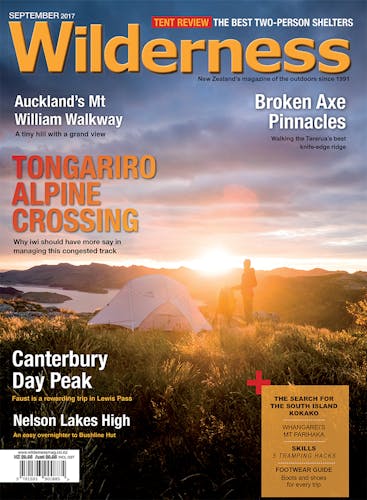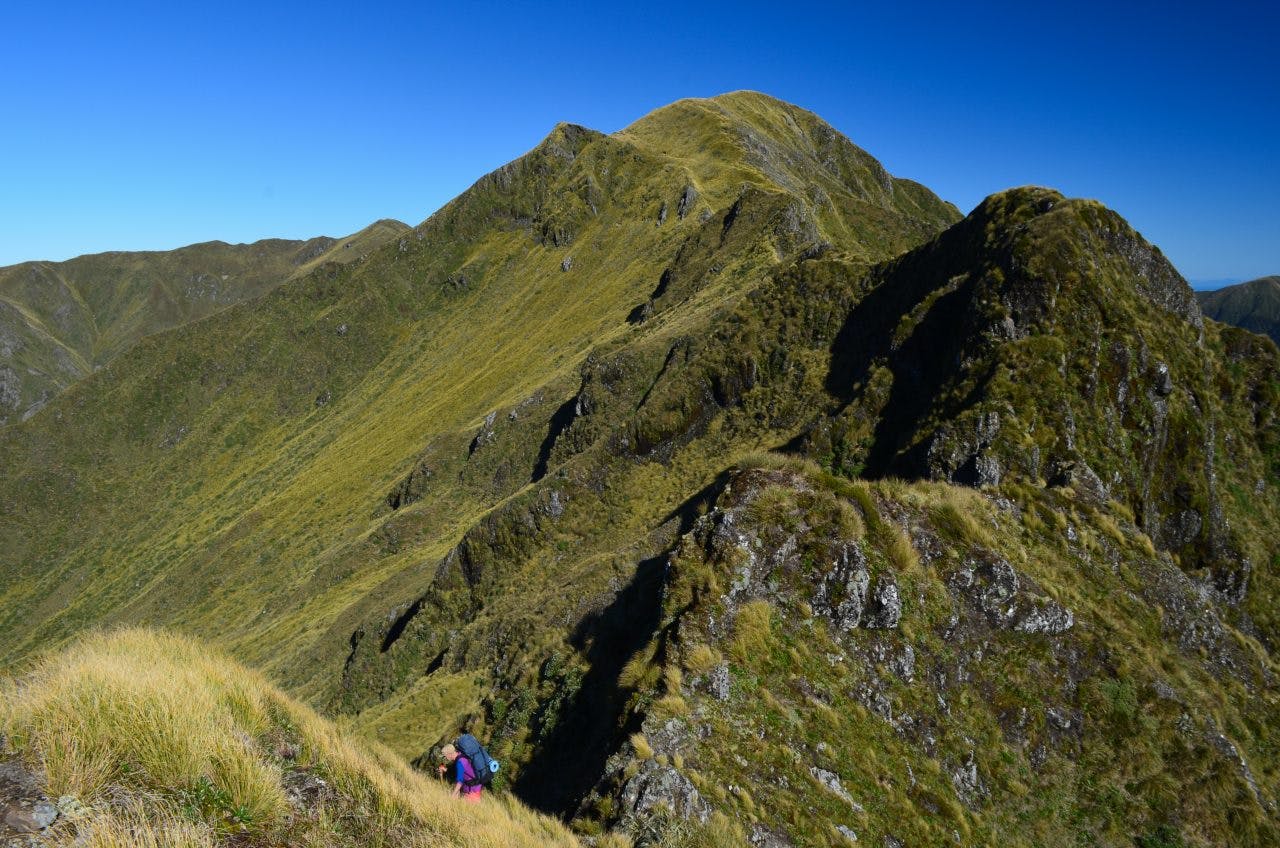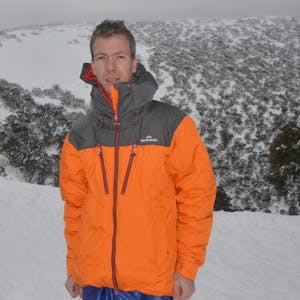- Distance
- 38.5km
- Total Ascent
- 3355m
- Time
- Holdsworth Lodge to Jumbo Hut, 4-5hr; Jumbo Hut to Broken Axe Pinnacles, 2-3hr; Pinnacles to Tarn Ridge Hut, 4-6hr; Tarn Ridge Hut to Mitre Flats Hut, 4-5hr; Mitre Flats Hut to Atiwhakatu Hut, 4-5hr; Atiwhakatu Hut to Holdsworth Lodge, 2-3hr
- Accom.
- Atiwhakatu Hut ($5, 26 bunks), Jumbo Hut ($15, 20 bunks), Tarn Ridge Hut ($5, 16 bunks), Mitre Flats Hut ($15, 14 bunks)
- Access
- From the end of Mount Holdsworth Road
- Map
- BP34, BN34
- Notes & Map
- Broken Axe Pinnacles (pdf, 2 MB)
To mark Wilderness magazine’s 30th anniversary, current and past editors and contributors scoured the archives for the 30 best trips we’ve published over the decades. This story, original published in September 2017, was included. You can find all 30 of the greatest Wilderness trips in the October 2021 issue.
Of the few knife-edge ridges in Tararua Forest Park, the Broken Axe Pinnacles are the most gripping.
For a moment, I thought we’d come to the wrong forest park.
The track between the Holdsworth Road end and Atiwhakatu Hut is an anomaly in the Tararuas in that it is completely dry, comfortable, safe and relatively luxurious, with a gravel-clad surface and bridges capable of suspending semi-trailers spanning the merest trickle of a stream. No bog, no tree roots, no need to scrutinise the ground for anything that may send you instantly and irredeemably onto your face. it’s not far away from being wheelchair accessible.
It’s a remarkable juxtaposition to what lies just ahead, on this three night circuit around the valleys and tops of the formidable range.
The beech forest receded as we climbed the steep track that leads from the Atiwhakatu Stream to Jumbo Hut, situated just above the bushline, at 1200m. After a slow slog, weighed down by heavy first-day packs, we emerged from the bush and arrived at the hut by mid-afternoon. It was good timing: a group of school students were packing up to leave.
We were lured onto the tops above the hut by a breathtaking sunset, where the mist rolled off and the spines and bulges of the Tararuas were revealed, including the highest peak, Mitre (1571m), and the saw-tooth silhouette of the Broken Axe Pinnacles, our day two destiny.
We woke to weather as ‘un-Tararuas’ as the track to Atiwhakatu. Still, cloudless, warm and the hills coated in a glorious, benign orange light. The kind of morning that pulls you out of bed and sends you rushing to pack, so you can tramp this great country before the inevitable mist rolls in, the wind whips up and the colour drains from the land.
From Jumbo Hut, the track follows the ridgeline north, climbing up and down various peaks and saddles, typical of much of the travel in the Tararuas. During conditions of low cloud (known in the Tararuas as ‘clag’) some navigation with a map and compass is required to avoid following the wrong ridge, but on a clear day the route is well-defined. Our first major climb was Angle Knob. Views of the western ranges open up at this point, orange hills rolling on forever, and the Waiohine River cutting a narrow trail to the west as it winds through gorges rimmed by thick native bush far below.
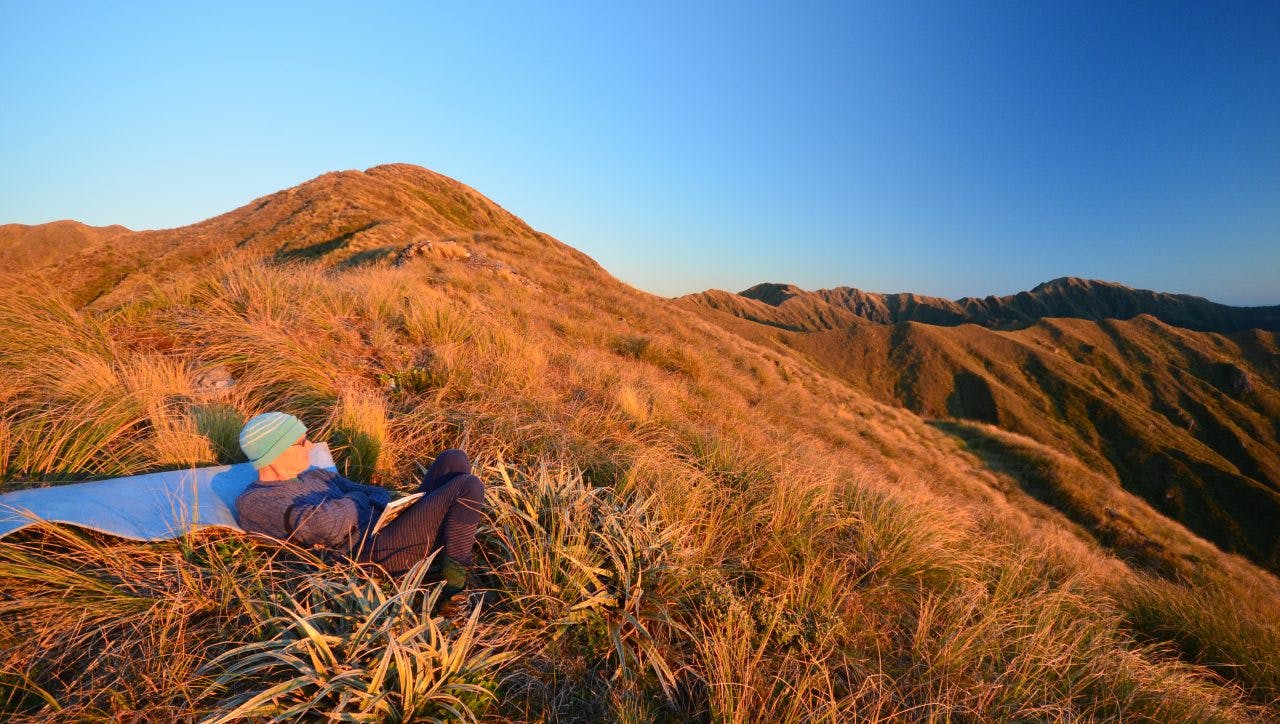
Watching the sunset from ridge just above Jumbo Hut, Broken Axe Pinnacles and the route travelled in the far distance. Photo: Ricky French
The Broken Axe Pinnacles sneak up on you. One minute you’re walking along a broad ridge, then next minute there’s a shear drop either side as the land falls away. A sidle track has been cut, which skirts the worst of the pinnacles, but it’s still an uncomfortable bash across the side of a scrubby mountain.
But we weren’t here to sidle. Taking a deep breath, I scrambled carefully up to the main ledge, which walks a tightrope leading to a second bump. There wasn’t a breath of wind; it was unnervingly quiet.
“Are you sure we’re in the Tararuas?” I called back to Bruce. But Bruce didn’t answer, as he was too busy trying to keep from falling off the mountain.
You don’t get many jagged, knife-edge ridges in the Tararuas. There’s a certain uniformity in the shape and contours of the major tops routes, and Broken Axe Pinnacles is by far the most gripping (both literally and figuratively) of the obstacles.
Luckily, an iron loop is anchored to a rock to enable packs to be lowered on a rope. Unluckily, we didn’t have a rope. It was only absolute necessity that got me down the rock-face. There was no other option. Going backwards meant the weight of my back was intent on pulling me into the lower reaches of the valley, but there was no other way. I hugged the mountainside and grunted and poked my fingers into every finger-hold and summoned all resolve, wishing I was twenty years younger, when self-preservation hadn’t yet become a pressing instinct. Finally, I jumped. The ledge held, but my knees didn’t. I managed a controlled slide down the last of it and threw off my pack at the bottom. The relief was immense. But Bruce was still up there, his 60-year old body not quite in the shape for similar feats.
I climbed back up and we devised an improvised system of pack-lowering/pack dropping that was ultimately successful in conveying both pack and packhorse through the pinnacles.
With danger now behind, we happily toiled the day away in the sun, following the ridge and watching the changing view.
The final climb of the day was Girdlestone. By this point, our water had run out and fatigue was setting in. I had never before considered heat-stroke as a possible hazard in the Tararuas. We’d been walking for over eight hours and our bodies were crying out for rest and rehydration. Fortunately, Tarn Ridge Hut came into view, into which we soon collapsed in a heap.
Tarn Ridge is relatively new, and is located deep in the ranges, nestled on a small sheltered bench just off the main ridge. Nearby is the grave of a tramper, Basil Blatchford, who succumbed to hypothermia during a storm in 1959 on a day where the Tararuas may as well have been another planet to the one on which we now resided.
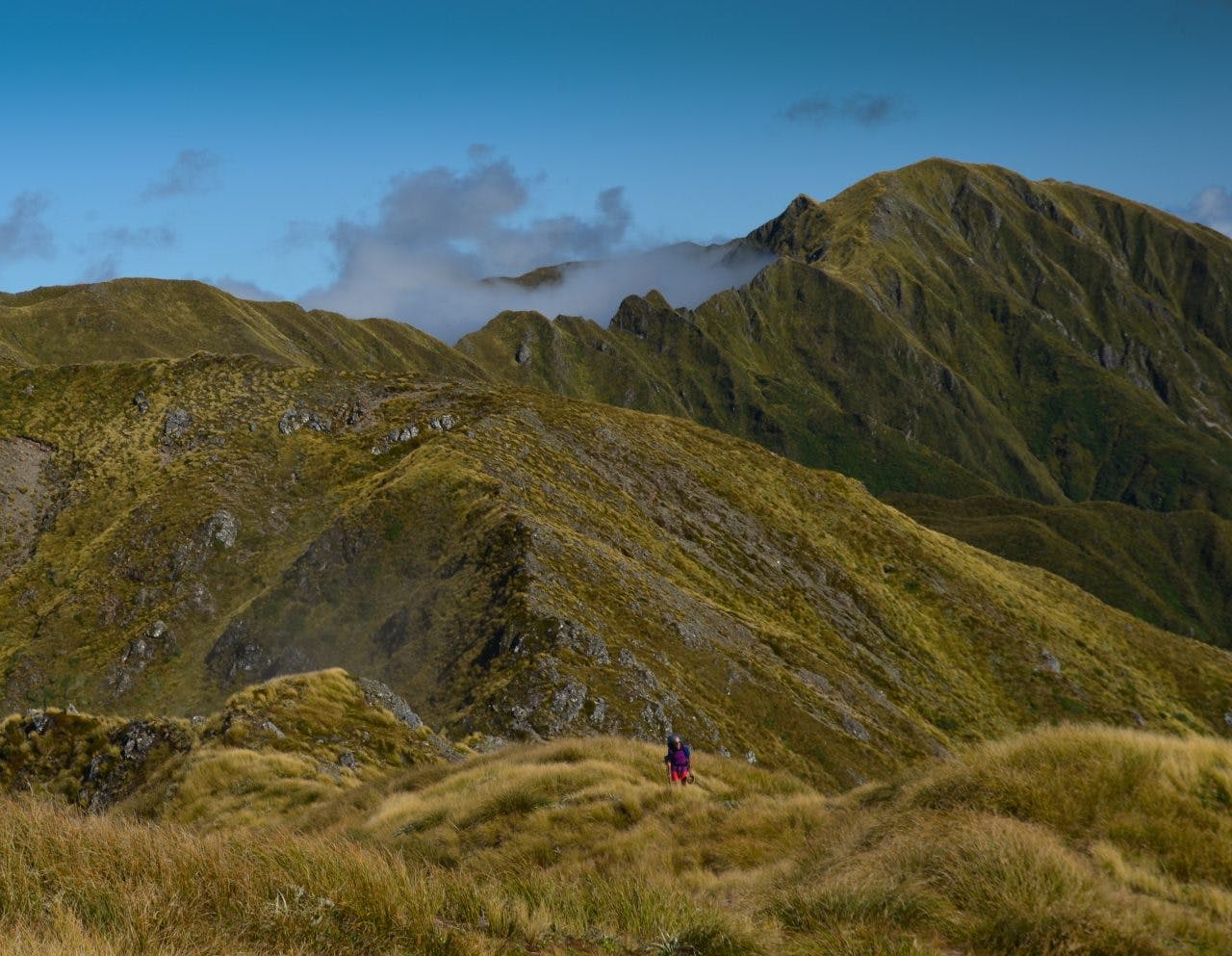
Tramping along the tops after traversing the Broken Axe Pinnacles, pictured in the background. Photo: Ricky French
We were treated to another stunning sunset, and we marvelled at how overlooked this amazing mountain range is. To the west was the shimmering surface of the Tasman Sea. Closer, the patterned folds of the different ridges, circling our tiny, hidden spot amongst the tussock grass. The sun finally dipped below Kapiti Island, sending shards of yellow to pierce the giant bulges of the main range, leaving the sky to melt orange and darkness to close the door on a magical, rare Tararua day.
Huey was up first in the morning. He got changed into his work clothes; grey overalls. It was early and he was grumpy; his sunny disposition but a memory. It was nothing if not inevitable. Clag does have its advantages. You don’t dawdle. Nothing to see here, move along. And so we did, until Girdlestone was climbed for the second time and we located the ridge leading to Mitre.
Walking into the saddle below the final assault, the clouds parted just enough to expose the huge mound that was the highest peak in the ranges. I’d last climbed this in 1992. I was only 12, but probably in the best tramping shape of my life. I certainly don’t remember the straining leg muscles and thumping heart beat that dominated this slog up the steep western face.
We zig-zagged through rock bands and used tussock clump hand-holds to propel ourselves towards the summit. On top, we threw off our packs and smiled. We were on top of the Tararua Ranges.
From Mitre we faced an extended descent along an eroded ridge into the Waingawa River. We passed several parties heading up, making the day trip to climb Mitre.
The track re-entered the bush halfway down, and we arrived at Mitre Flats Hut, on the banks of the Waingawa, at mid-afternoon. Mitre Flats is large and comfortable, but it wasn’t our destination for the night. We needed to be back at the car by late morning the following day, which meant making a dash for Atiwhakatu Hut.
We’d heard that the track from Mitre Flats to Atiwhakatu was a real stinker. So we were prepared for mud, fallen trees, indistinct markings, overgrown vegetation and anything else the Tararuas can throw at you. But the track proved to be perfectly governable and quite pretty, taking us through a diversity of bush and riverside scrub.
Several good camp spots by the river appeared, and in hindsight we should maybe have taken one of them and slept out in the open beside a fire, rather than pushing on to a full Atiwhakatu Hut. It was a vastly different scene from two days ago when we stopped for lunch. Families, sporting teams and a rag tag bunch of allsorts had converged on the ultra-accessible hut for the weekend. After the silence and peacefulness of the remote ridgelines, it was a shocking jolt.
We slept a restless night on the floor, in a hut much too hot, and left early in the morning for home.
But the strange experience only highlighted how lucky we were to spend two days by ourselves, prancing on ridgelines stretching forever, tackling nature’s pinnacles and peaks, watching the sun set on the enigma that is the Tararuas – the mountain range you can tramp your whole life, but never really know.
How Broken Axe Pinnacles got its name
Long-time tararua tramper John Rhodes has researched the origin of the name Broken Axe Pinnacles. He discovered that Charles Bannister named the jagged peaks after the discovery of a broken Maori axe found there by two trampers – Harry Holmes and Jack Gardener – around 1900.
Rhodes was unable to unearth much else, though he did stumble upon this interesting titbit: Harry Holmes was a deerstalker and his homestead is now occupied by film director Peter Jackson.
Rhodes also recorded an alternative name for the pinnacles: Scrambled Eggs Cliff, suggested by amateur map maker W.C Duncan in the 1930s.
But Broken Axe Pinnacles was already too well-known for that name to stick.
More photos from this trip…












